


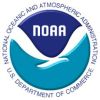
Bering Sea-Ice Expedition
Research Activities- Phytoplankton
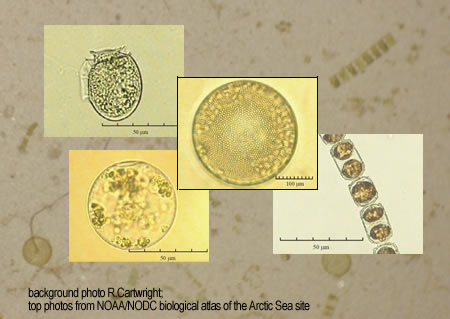
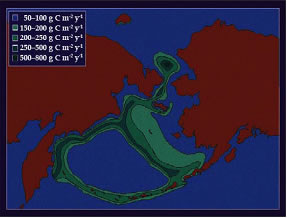 |
The "Green Belt" is a term coined by scientists at the University of Alaska Fairbanks to describe the region of prolific and prolonged primary production in the Bering Sea. |
Phytoplankton are microscopic plants, also called microflora, that use sunlight and nutrients to synthesize carbon through photosynthesis, just like plants on land. Different species of phytoplankton exist in oceans throughout the world. They all play an important role in the exchange of carbon dioxide between the atmosphere and the ocean, and hence, climate change. You can think of phytoplankton as the vegetables of the sea, the base of the marine food chain. In the fertile Bering Sea, the region of high phytoplankton growth (primary productivity) is called the “Green Belt”. Changes in sea ice concentration and duration affect the primary productivity, which then affects the entire ecosystem.
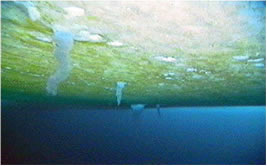 |
Ice algae form mats on the underside of sea ice. Photo by Doug Allen, Change in Arctic Marine Production [CAMP] Project. |
Springtime phytoplankton
blooms in the eastern Bering Sea occur in two different ways: they
can start due to ice melt (early, ice-associated bloom), or they can
happen later in the season as sunlight increases (late, open-water
bloom). In the early bloom situation, the marine food chain begins with ice
algae that grow in brine channels on the underside of ice floes in
the dark of winter. These algae form mats under the ice, and with the
growing amount of sunlight during spring, a bloom develops in the water
beneath the ice. As the ice begins to break-up, the bloom spreads into
a wide 20-80 kilometer belt surrounding the ice edge.
When ice is not present (or melts too early in the spring), the bloom occurs later, in open water. Zooplankton, microscopic animals on the next rung of the food chain, are more plentiful at this time, and the majority of the phytoplankton bloom is consumed by the zooplankton. The zooplankton, in turn, are eaten by fishes, mammals and seabirds. Less organic material falls to the bottom, and the benthic community goes hungry. Thus, the timing of sea ice in the Bering Sea is very important in determining what type of ecosystem will flourish there (benthic or bottom dwelling vs. pelagic or water column).
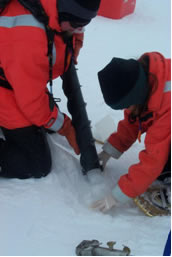 |
| Scientists extract an ice core from the auger used to drill it. Photo from National Science Foundation’s GenEx2 project. |
During this expedition, scientists will sample phytoplankton from within the ice, under the ice, and in the open water. Similarities in species of sampled phytoplankton could suggest that the ice species are “seeding” the spring water column. To sample phytoplankton within the ice, scientists will drill into ice floes to extract cores of ice. The cores will be cut into sections, the sections will be put into sample bags and allowed to melt, and phytoplankton within the lowest 10 cm of the core (the part that was in contact with sea water) will be identified and counted (using microscopes). To sample phytoplankton under the ice, divers will dive under the ice and use a “slurp gun” to take water samples from just beneath the ice. Again, phytoplankton in these water samples will be identified and counted. Water-column phytoplankton samples are collected with a Niskin bottle, a device that is placed in the water in an open position and programmed to shut at a specific depth. Within-ice and below-ice samples will be compared to samples taken from the ice-free ocean near the ice edge and farther away. We will also estimate the growth rates of ice algae and phytoplankton samples by adding stable isotopes (carbon and nitrogen), incubating samples in an on-deck incubator for several hours, filtering the sample, and measuring the amount of stable isotope increase in the cells captured on the filter. For these incubations, temperatures are held constant by flushing the incubator with surface seawater, and light levels will be simulated using screened bags. These analyses will give us a better understanding of what species of phytoplankton are contributing to the ecosystem both in and near the ice and farther away. This information will allow us to better understand and predict the influence of changing sea ice conditions on the base of the food chain.